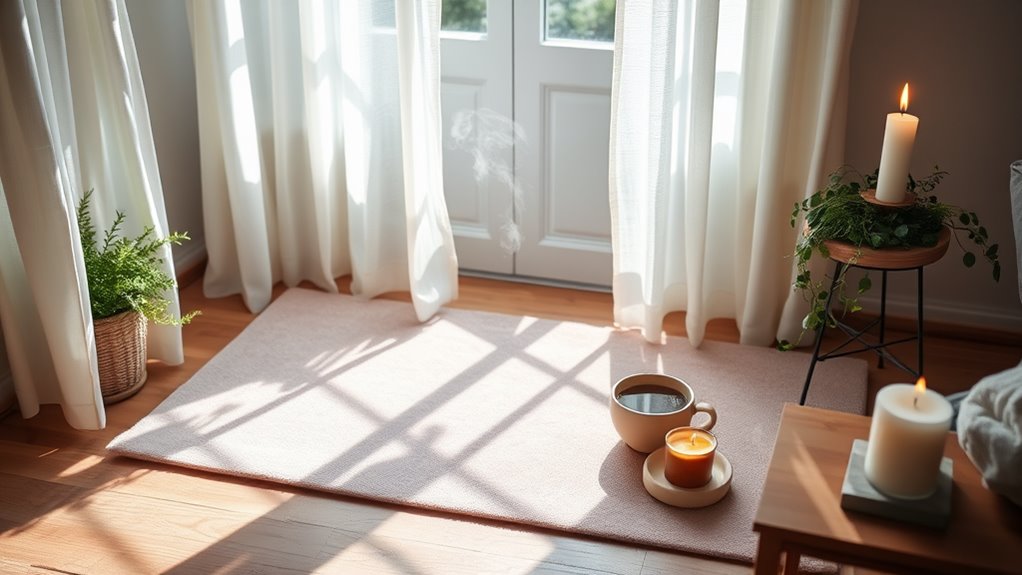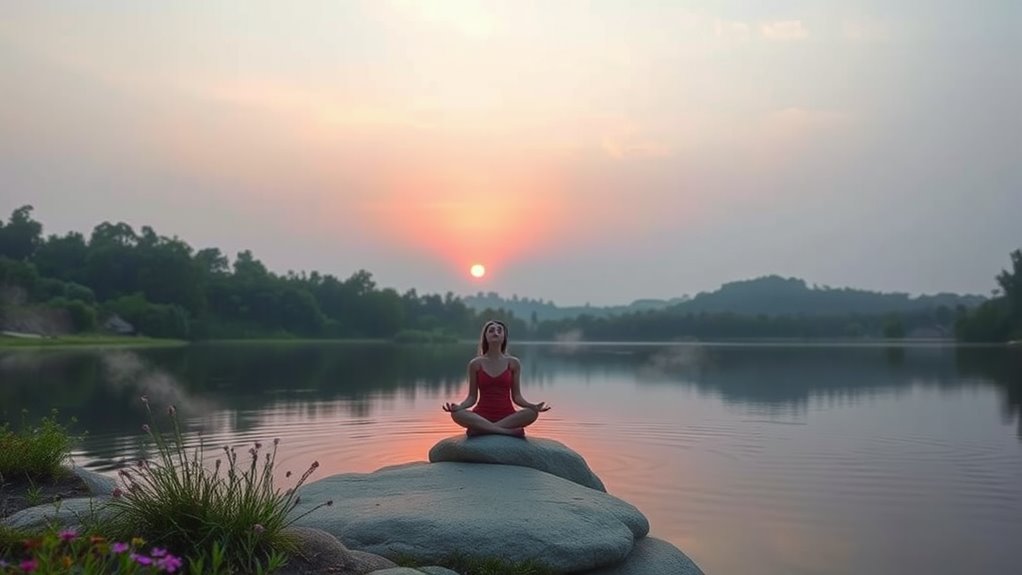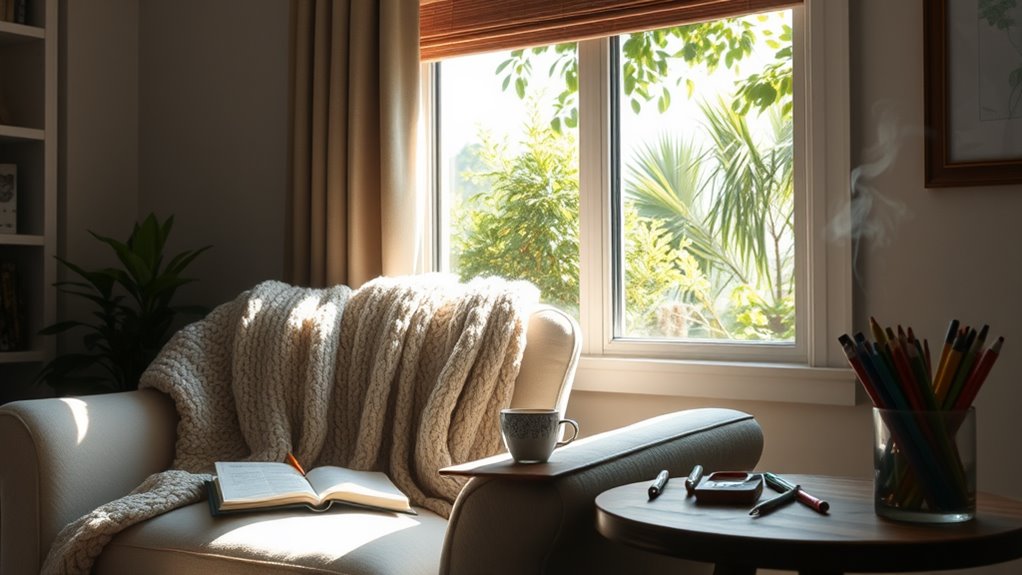Relaxation Techniques That Instantly Calm Your Mind
You can quickly calm your mind with a few effective relaxation techniques. Start with deep breathing exercises—inhale through your nose, hold, and exhale slowly through your mouth. Progressive muscle relaxation helps, too; tense each muscle group, hold, and release. Mindful meditation is another great option—focus on your breath and pay attention to different body parts. Quick visualization practices can transport you to serene places, like a peaceful beach or a cozy room. Finally, grounding techniques engage your senses, helping you stay present. Keep exploring to discover even more methods for achieving instant tranquility.
Key Takeaways
- Deep breathing exercises activate relaxation responses, helping to calm the mind through focused inhalation and exhalation.
- Progressive muscle relaxation systematically releases tension, promoting a sense of calm by focusing on muscle groups.
- Mindful meditation techniques enhance awareness and presence, reducing stress through focused breathing and gratitude reflection.
- Quick visualization practices create calming mental images, transporting the mind to serene settings for instant stress relief.
- Grounding techniques, like the “5-4-3-2-1” method, anchor you in the present moment, promoting tranquility through sensory engagement.
Deep Breathing Exercises
Deep breathing exercises are one of the simplest yet most effective ways to reduce stress and promote relaxation. When you focus on your breath, you activate your body’s relaxation response.
Start by finding a comfortable position, either sitting or lying down. Inhale deeply through your nose, allowing your abdomen to expand fully. Hold that breath for a moment, then exhale slowly through your mouth.
Repeat this process for several minutes, concentrating on each breath. You’ll notice how your body begins to feel lighter and your mind clearer.
For even greater benefits, try counting your inhales and exhales. This technique helps you stay focused and present, pulling you away from distractions and worries.
Incorporate deep breathing into your daily routine for lasting calm.
Progressive Muscle Relaxation
While you may often hold tension in your muscles without realizing it, progressive muscle relaxation (PMR) offers a straightforward way to release that stress.
This technique guides you through tensing and relaxing different muscle groups, helping you tune into your body. Here’s how to practice PMR:
- Start with your toes: Squeeze them tightly, hold for five seconds, then release.
- Move to your calves: Tense them for five seconds, then let go and feel the relaxation.
- Focus on your shoulders: Raise them towards your ears, hold, then drop them down.
- Finish with your face: Scrunch your facial muscles, hold, then relax completely.
As you progress through each muscle group, you’ll notice a profound sense of calm and relief.
Mindful Meditation Techniques
Mindful meditation techniques can transform your daily routine by fostering a greater awareness of your thoughts and feelings. By dedicating just a few minutes each day, you can cultivate a state of calm and clarity. Start with focused breathing—inhale deeply, hold, then exhale slowly. Next, engage in a body scan, paying attention to each part of your body. Finally, practice gratitude by reflecting on positive aspects of your life.
| Technique | Duration | Benefits |
|---|---|---|
| Focused Breathing | 5 minutes | Reduces anxiety |
| Body Scan | 10 minutes | Enhances relaxation |
| Gratitude Reflection | 5 minutes | Boosts mood |
Incorporating these techniques into your routine can lead to a more peaceful mindset.
Quick Visualization Practices
Building on the awareness gained from mindful meditation, quick visualization practices can further enhance your ability to relax and focus.
These techniques allow you to create calming images in your mind, helping you escape from stress.
Try these quick visualization practices:
-
A serene beach****: Picture the soft waves lapping at your feet and the warmth of the sun on your skin.
-
A peaceful forest: Imagine walking through tall trees, surrounded by the sounds of birds and rustling leaves.
-
A tranquil mountain: Visualize standing at the peak, breathing in the fresh air and taking in the breathtaking view.
-
A cozy room: Envision curling up in a soft blanket, sipping tea, and feeling completely at ease.
Let these images wash over you and promote relaxation.
Grounding Techniques for Calmness
How can you quickly regain your sense of calm? Grounding techniques are your best bet. Start by focusing on your breath; take deep, slow inhales and exhales.
Next, engage your senses—notice five things you can see, four you can touch, three you can hear, two you can smell, and one you can taste. This practice pulls you back into the present moment.
You can also try the “5-4-3-2-1” technique, which helps anchor you in reality. If you’re outside, feel the ground beneath your feet or the breeze against your skin.
These simple practices can help you reconnect with your surroundings and promote a sense of tranquility. Remember, it’s all about being present and aware.
Frequently Asked Questions
How Often Should I Practice Relaxation Techniques for Best Results?
You should practice relaxation techniques regularly, ideally daily, to see the best results. Consistency helps your body and mind adapt, making it easier to unwind and cope with stress when you need it most.
Can Relaxation Techniques Improve Sleep Quality?
Yes, relaxation techniques can definitely improve your sleep quality. By calming your mind and reducing stress before bedtime, you help your body shift into a restful state, making it easier to fall asleep and stay asleep.
Are There Any Risks Associated With These Techniques?
Yes, there can be risks associated with relaxation techniques. You might experience heightened anxiety, discomfort, or frustration if the methods don’t suit you. Always listen to your body and consult a professional if unsure.
Can I Use Relaxation Techniques During Stressful Situations?
Absolutely, you can use relaxation techniques during stressful situations. They help you regain focus and calm your mind. Just take a moment to breathe deeply or visualize a peaceful scene to quickly alleviate tension.
How Do I Choose the Right Technique for Me?
To choose the right technique for you, consider your preferences and needs. Experiment with various methods, like deep breathing or visualization, and notice what resonates. Trust your instincts to find what truly helps you relax.





